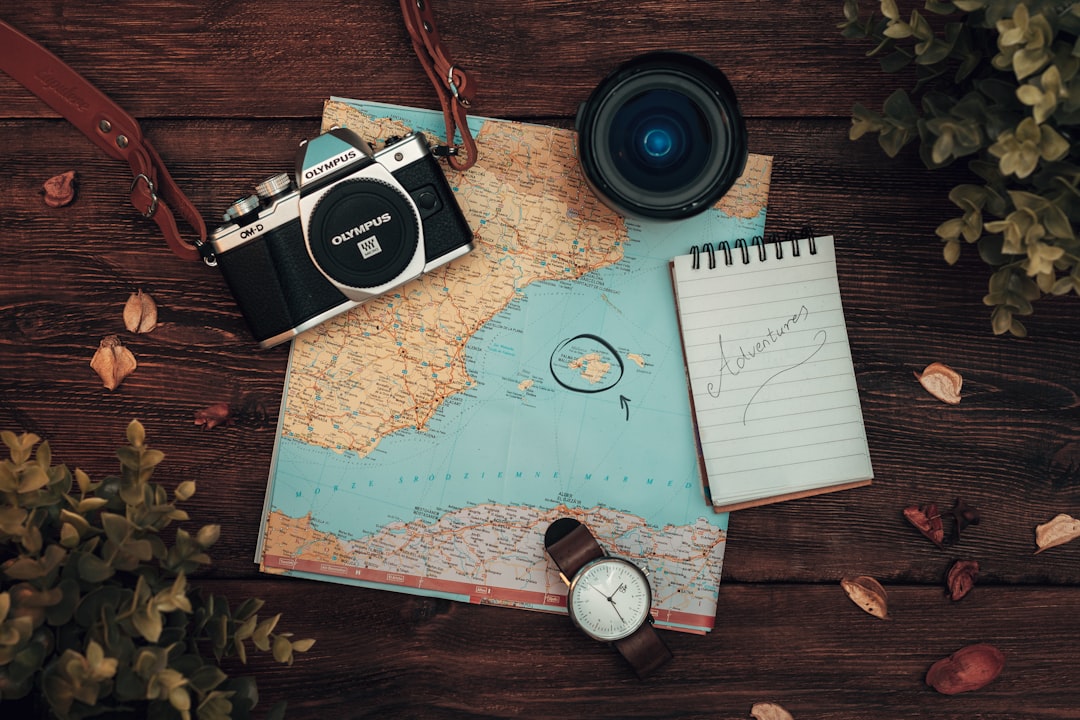Trip Preparation List: 7 Painless Ways
Why Every Traveler Needs a Solid Trip Preparation List
A trip preparation list is your ultimate tool for stress-free travel. Whether you’re heading to a nearby city or flying across the globe, a well-prepared checklist prevents frustrating “Did I forget something?” moments and is the difference between arriving flustered and arriving ready to explore.
Forgetting your phone charger or having your luggage lost without a change of clothes in your carry-on can ruin a vacation. A comprehensive trip preparation list doesn’t have to be overwhelming. With the right approach, you can build a reusable system that makes every future trip easier.
At GoTravelHunt, we help travelers organize stress-free trips by breaking down the trip preparation list into simple, actionable steps. Successful travel, like any project, starts with solid planning.
Essential Categories:
- Documents: Passport, visa, ID, travel insurance, boarding passes
- Money & Cards: Credit cards, cash, bank contact numbers
- Health Items: Medications, first-aid kit, prescriptions, hand sanitizer
- Clothing: Versatile layers, underwear, socks, shoes for your destination
- Toiletries: Travel-sized shampoo, toothbrush, sunscreen, deodorant
- Electronics: Phone charger, power bank, universal adapter, headphones
- Carry-On Essentials: Change of clothes, valuables, medications, documents
Pre-Trip Tasks:
- Book flights and accommodations 1-2 months ahead
- Check passport validity (needs 6+ months for most countries)
- Notify your bank about travel dates
- Enroll in travel alerts (like STEP for international trips)
- Confirm all reservations one week before departure
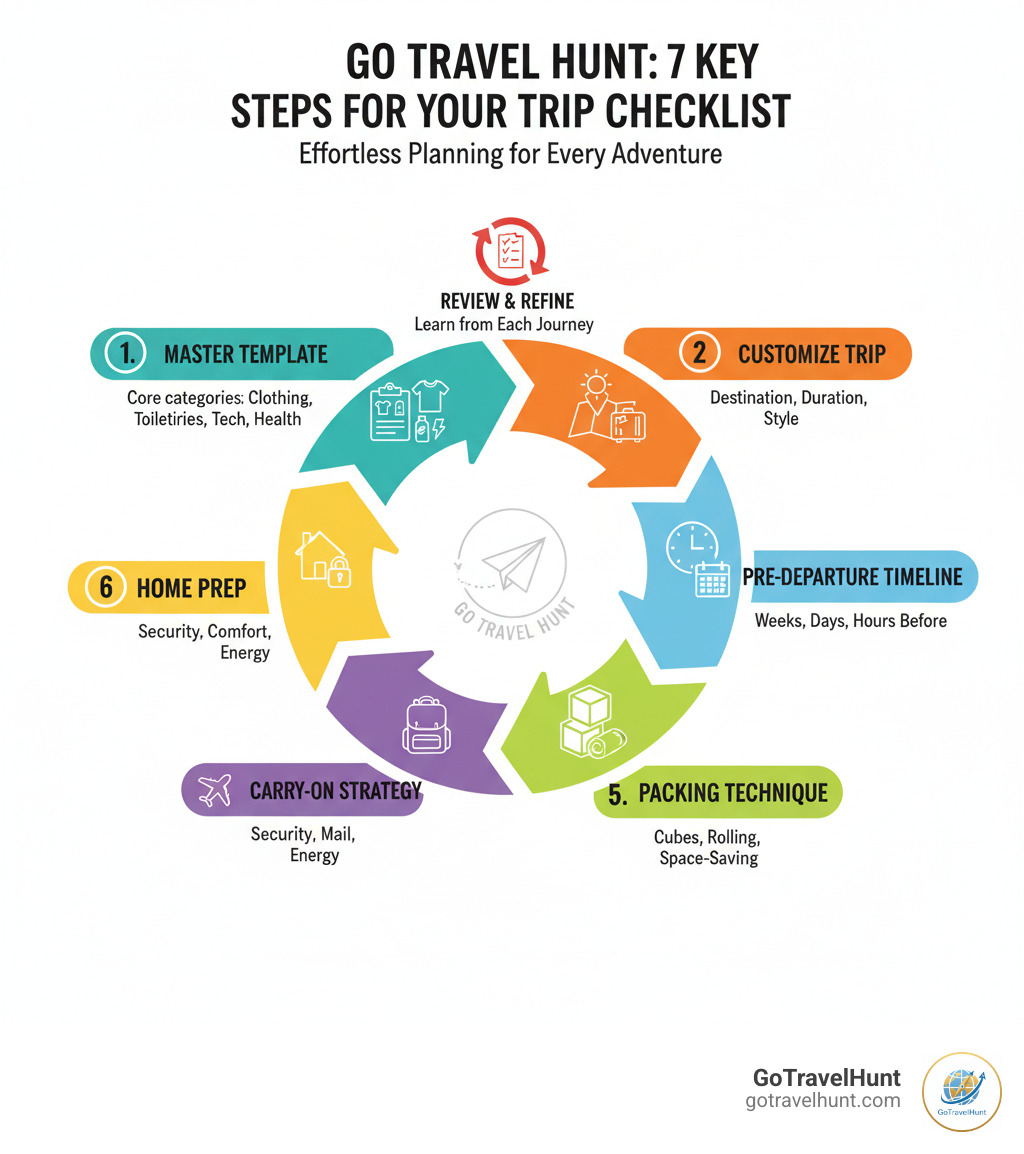
Basic trip preparation list terms:
1. Start with a Master Template: The Core Categories
Every great trip preparation list starts with a solid foundation—a master template that covers all the essentials before you customize it for your specific adventure. Whether you’re jetting off to Paris or road-tripping to the mountains, these core categories ensure nothing important gets left behind.
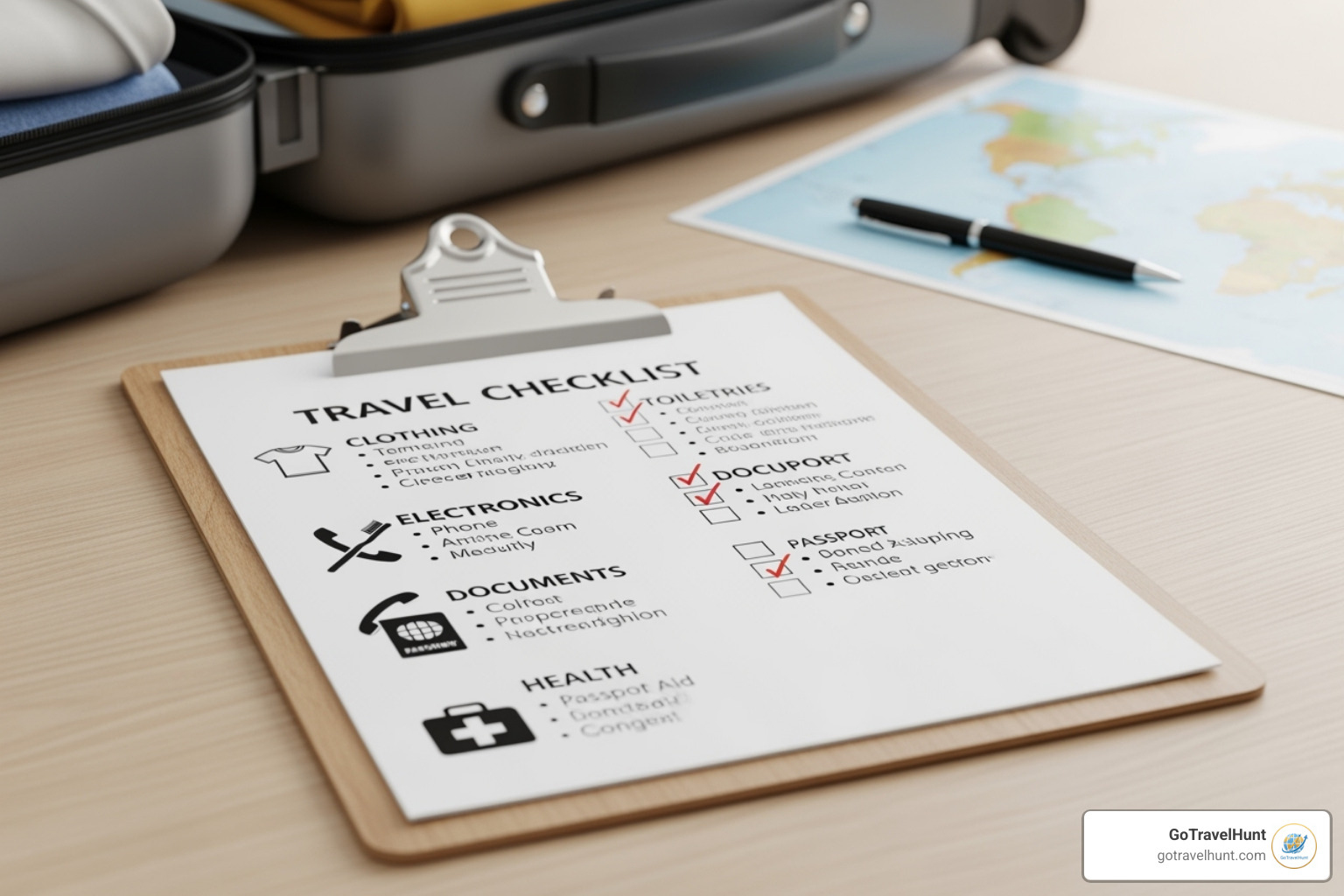
This foundational step ensures you cover all the basics before customizing your list.
Clothing and Accessories
Clothing typically takes up the most space, so smart choices are key. The secret is packing versatile pieces that mix and match easily. For a 3-5 day trip, pack one pair of underwear and socks per day, a set of pajamas, a few outfits (casual, active, dressy), and limit yourself to two pairs of shoes. For longer trips, scale up the outfits but stick to the two-shoe rule to save space.
Game-changing items include multi-use wraps, crushable hats, Merino wool layers for temperature regulation, quick-drying activewear, and UPF-proof clothing. A lightweight nylon jacket beats a bulky sweatshirt, and wrinkle-resistant shirts are worth the investment. For more tips, see our City Break Packing List.
Don’t forget accessories like belts, jewelry, a collapsible tote for souvenirs, a compact umbrella, and a laundry kit for longer trips.
Toiletries and Personal Hygiene
To pack toiletries efficiently and comply with airline rules, transfer your favorite products into travel-sized, reusable containers. This saves space and helps you breeze through TSA security screening.
Your checklist should include a toothbrush, toothpaste, floss, soap, deodorant, shampoo, and conditioner. Also pack your hair brush, styling tools, facial cleanser, moisturizer, and sunscreen. If you wear contacts, bring your lenses, solution, and backup glasses. Personal items like shaving supplies, makeup, and menstrual products can be hard to find in your preferred brands abroad. Complete your kit with nail clippers, tweezers, and hand sanitizer. You can easily shop for travel toiletries online.
Health and Medical Kit
A well-stocked health kit turns potential disasters into minor inconveniences. The CDC’s guide to packing smart emphasizes being prepared.
Your prescription medications should always travel in their original containers with a copy of your prescription. Check with the U.S. Embassy for your destination, as some medications may be restricted.
A basic first-aid kit is non-negotiable. Include bandages, antiseptic cream, pain relievers, fever reducers, and allergy medication. Also pack stomach and diarrhea relief medication, motion sickness medicine, and insect repellent if needed. Sunscreen, aftersun lotion, hand sanitizer, and disinfecting wipes are also crucial.
Electronics and Gadgets
Your phone and charger are essential; pack the charger in your carry-on. A portable power bank is your insurance against a dead battery. For international trips, a universal travel adapter and converter is a must. Check power plug types for your destination before you leave.
Quality headphones (especially noise-cancelling) make flights more bearable. Bring your camera and extra memory cards to capture memories. An e-reader or tablet provides entertainment during downtime. Finally, don’t forget protective cases for your electronics to prevent damage like a cracked screen while abroad.
2. Customize for Your Destination, Duration, and Trip Style
Here’s where your trip preparation list gets personal. A generic list is a good start, but customizing it for your destination, trip length, and travel style makes all the difference. Packing for a beach vacation in Thailand is nothing like preparing for a weekend in Iceland.
International vs. Domestic Travel
International travel requires extra planning. The stakes are higher, and you can’t just run to a familiar store if you forget something.
- Passport and Visa: Check that your passport is valid for at least six months after your return date. Research visa requirements on the U.S. Department of State’s website and apply well in advance.
- Document Copies: Make multiple copies of your passport, visa, flight confirmations, and travel insurance. Keep one set separate from the originals, give one to a trusted person at home, and save digital copies to your phone or cloud storage.
- Financial Prep: Notify your bank and credit card companies of your travel dates to avoid account freezes. Pack cards with no foreign transaction fees, a debit card for ATM withdrawals, and some local currency obtained before departure. Use a money belt for security.
- Driving: If you plan to drive, you may need an International Driving Permit (IDP) from AAA. Verify your auto insurance coverage abroad.
- Medications & Customs: Research local laws for your prescription medications, as some may be restricted. Carry them in original containers with a copy of the prescription. Learning a few basic local phrases also shows respect and improves your experience. Our Best Things to Pack for International Travel guide has more details.
Trip Duration and Climate
Your trip’s length and weather forecast will shape your packing strategy.
- Short Trips (3-5 days): Pack light, aiming for carry-on only. This saves on fees and eliminates the risk of lost luggage.
- Longer Trips (1+ week): Pack versatile outfits and plan to do laundry. Quick-dry fabrics are a game-changer.
- Cold Weather: Use a layering strategy: thermal base layers, fleece or wool mid-layers, and a waterproof/windproof outer shell. Don’t forget a hat, gloves, scarf, and insulated, waterproof boots. Find your next winter vacation spot here.
- Warm Weather: Focus on lightweight, breathable fabrics like cotton and linen. Pack swimsuits, cover-ups, shorts, t-shirts, sandals, a wide-brimmed hat, sunglasses, and plenty of sunscreen.
- Always Pack Layers: Weather can be unpredictable. A packable jacket or cardigan is always a good idea. A compact umbrella or rain jacket can save a rainy day.
Travel Style: Adventure, Family, or Relaxation
Your travel personality dictates your gear.
- Adventure Travel: Requires specialized gear like sturdy hiking boots, moisture-wicking activewear, a daypack, and possibly trekking poles or a water purifier.
- Family Travel: Involves packing extra clothing, snacks, entertainment, and specific medications for kids. Check our Family Travel Tips for help.
- Relaxation/Beach Trips: Focus on comfort with multiple swimsuits, cover-ups, casual dresses, sandals, and a good book.
- Romantic Getaways: May require a few dressier outfits for special occasions. Find inspiration with our Ideas for a romantic getaway.
- Business Travel: Pack professional, wrinkle-resistant attire, comfortable travel clothes, and all necessary electronics.
3. Create a Pre-Departure Timeline
Breaking down your trip preparation list by time prevents last-minute scrambling. A timeline approach spreads tasks across weeks, making the process manageable and stress-free. Some tasks, like passport renewals, simply can’t be rushed.
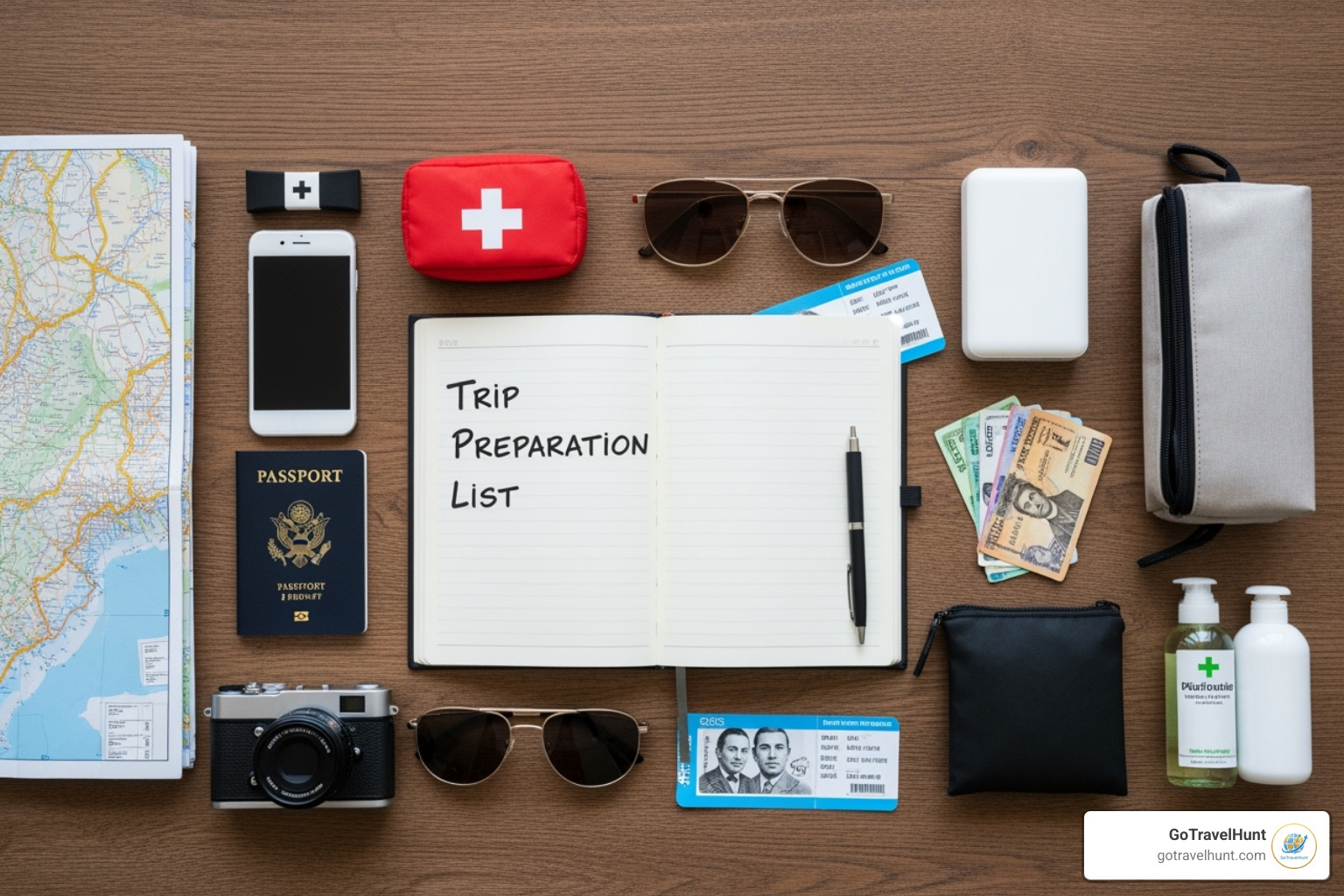
Breaking down tasks by timeline prevents last-minute panic and ensures a smooth departure.
Weeks Before You Go
This is the time for big-picture planning.
- Book Flights & Accommodations: Do this 1-2 months out (or earlier for popular destinations) to secure better prices and options. GoTravelHunt can help you find cheap flight deals.
- Check Passport & Visa: Verify your passport is valid for at least six months beyond your return date. If not, renew it immediately. Research and apply for any necessary visas.
- Arrange Care: Book pet sitters or arrange childcare, as they fill up quickly, especially around holidays.
- Consider Travel Insurance: A good policy provides peace of mind, as U.S. government health plans don’t cover you abroad.
- Enroll in STEP: For international travel, enroll in the free Smart Traveler Enrollment Program (STEP). The nearest U.S. embassy can contact you in an emergency.
The Week Of Your Trip
Shift from planning to confirming and final preparations.
- Confirm Reservations: Double-check all flights, hotels, rental cars, and tours.
- Notify Banks: Inform your bank and credit card companies of your travel dates to avoid fraud alerts. Inquire about foreign transaction fees.
- Get Local Currency: Exchange at least $50 into the local currency for immediate needs upon arrival, like taxis or tips.
- Refill Prescriptions: Ensure you have enough medication for the entire trip, plus a few extra days for delays. Keep them in their original containers.
- Share Itinerary: Give a copy of your flight details and accommodation info to a trusted friend or family member.
- Do Laundry: Pack from a clean wardrobe to avoid last-minute stress.
The Day Before Departure
Handle these final tasks for a smooth getaway.
- Finish Packing: Do a final check against your list.
- Charge Electronics: Charge your phone, power bank, camera, and any other devices to 100%.
- Download Offline Content: Save maps, movies, music, and e-books for use without an internet connection.
- Prep Your Home: Clean out the refrigerator, take out the trash, and set an out-of-office email reply.
- Prepare Your Carry-On: Pack your absolute essentials: passport, medications, a change of clothes, and valuables.
4. Perfect Your Packing Technique
The difference between a stressed traveler and a calm one often comes down to packing technique. Efficient packing saves space, reduces wrinkles, and makes finding items easy. Your trip preparation list isn’t just about what to pack—it’s about how to pack it.
The Ultimate Trip Preparation List for Packing
Start by choosing the right luggage. For many trips, a small carry-on suitcase and a backpack are all you need. Four-wheel luggage is great for navigating airports and city streets.
- Use Packing Cubes: These organizers compartmentalize your clothing, maximize space, and make unpacking and repacking simple.
- Roll, Don’t Fold (Usually): Rolling clothes generally saves more space and reduces wrinkles for items like t-shirts and jeans. For formal wear, folding may be better.
| Item Type | Best for Rolling | Best for Folding |
|---|---|---|
| T-shirts, Jeans | Saves space, reduces wrinkles, keeps clothes compact | Good for delicate items, allows for easy viewing of contents |
| Underwear, Socks | Excellent for filling small gaps, keeps them contained | Less efficient for space, but can prevent stretching |
| Sweaters | Reduces bulk, helps maintain shape | Minimizes creases in thicker materials |
| Dress Shirts | Can reduce harsh creases, but careful rolling is needed | Best for preventing wrinkles in formal wear, often laid flat on top of other items |
| Dresses, Skirts | Suitable for casual fabrics, can be rolled tightly | Ideal for delicate fabrics or formal dresses to avoid wrinkling |
- Limit Shoes: Shoes are bulky. Limit yourself to two pairs: one comfortable pair for walking (wear it on the plane) and one versatile pair.
- Wear Your Heaviest Items: Wear your bulkiest coat or boots on the plane to save luggage space.
- Plan for Laundry: On longer trips, doing laundry means you can pack fewer clothes. A travel laundry kit is small and effective.
- Pack Multi-Use Items: A sarong can be a scarf, blanket, or beach cover-up. Versatile pieces are packing gold.
If you’re short on time, our Last Minute Packing List is a great quick reference.
Complying with Airline Rules
Navigating airline rules is a critical part of your trip preparation list.
- Size and Weight Limits: Always check your specific carrier’s regulations for carry-on and checked baggage before you pack. They vary significantly.
- Baggage Fees: Most airlines charge for checked bags. Packing light enough for a carry-on can save you money and time at baggage claim.
- Liquid Restrictions: For carry-on bags, liquids, gels, and aerosols must be in containers of 3.4 ounces (100 ml) or less, all fitting in one quart-sized clear bag.
- Prohibited Items: Familiarize yourself with the TSA’s official website for a list of prohibited items to avoid surrendering them at security.
5. Strategize Your Carry-On Bag
Think of your carry-on as your travel safety net. It’s what saves you when your checked luggage gets delayed or lost. A smart carry-on strategy is the difference between a minor inconvenience and a vacation disaster.
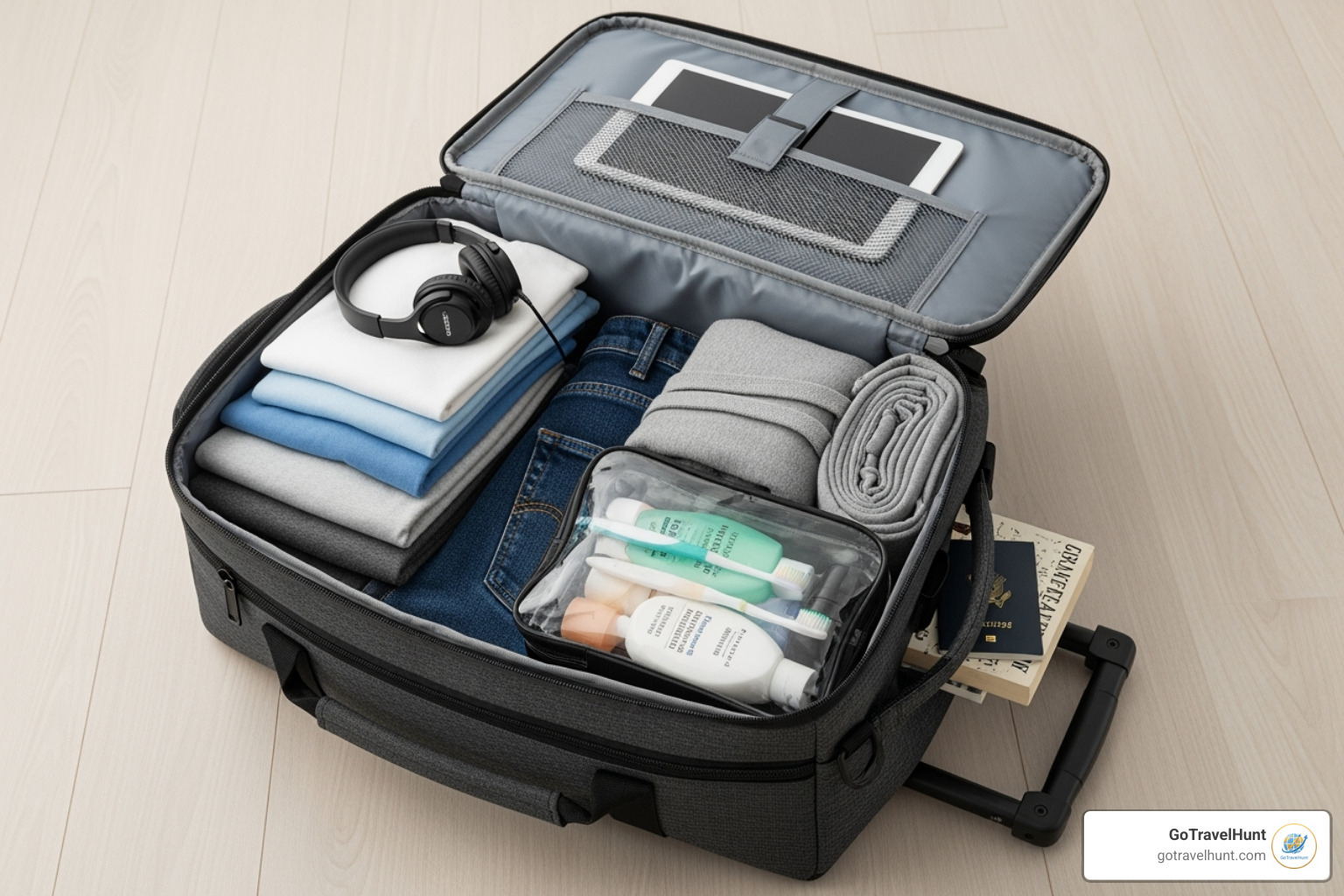
A well-packed carry-on is your lifeline in case of lost luggage and your comfort kit during travel.
Your In-Flight Personal Item
This bag should contain everything you absolutely cannot be separated from.
- Documents & Money: Your passport, ID, boarding pass (digital and printed backup), wallet, and cash are non-negotiable.
- Medications: Pack all daily prescriptions and basic over-the-counter medicines like pain relievers. Keep them in their original containers.
- Essential Electronics: Your phone, charger, and a portable power bank are must-haves.
- A Change of Clothes: An extra shirt and fresh underwear are crucial if your checked bag is delayed.
- Valuables: Keep items like jewelry, expensive electronics, or sentimental objects with you at all times.
- Itinerary: A printed copy from your Travel Itinerary Template with addresses and contacts is a great backup.
Comfort and Entertainment
Long flights are more manageable with a few comfort items.
- Sleep Aids: A travel pillow, eye mask, and earplugs are the holy trinity of in-flight rest.
- Hydration & Snacks: Bring an empty reusable water bottle to fill after security and a few non-perishable snacks.
- Headphones: Your own pair of Headphones will be more comfortable and offer better sound quality than the airline’s.
- Entertainment: A book or e-reader can make hours fly by.
- Refreshments: Pack lip balm, moisturizer, and disinfecting wipes to combat dry cabin air and clean your tray table and armrests.
6. Prepare Your Home for Your Absence
Before you leave, the final part of your trip preparation list is securing your home. This provides peace of mind, allowing you to relax and fully enjoy your vacation without worrying about what’s happening back home.
A Simple Trip Preparation List for Your Home
A few strategic steps can make all the difference.
- Manage Mail: Stop your mail and newspaper delivery, or ask a trusted neighbor to collect it. An overflowing mailbox is a clear sign that no one is home.
- Unplug Electronics: Unplug non-essential appliances like the coffee maker, toaster, and TV to save energy and protect them from power surges. Leave the refrigerator and security system plugged in.
- Adjust Thermostat: Set your thermostat to an energy-saving temperature—higher in summer, lower in winter (but not low enough for pipes to freeze).
- Lock Up: Do a final walkthrough to ensure all windows and doors are securely locked.
- Inform a Neighbor: Let a trusted neighbor know you’ll be away and provide them with emergency contact information.
- Care for Plants: Give your plants a good watering. For longer trips, ask a neighbor to help or use self-watering globes.
- Take Out Trash: Empty all trash cans in the house to avoid returning to unpleasant odors.
- Use Light Timers: Set timers for lights in different rooms to simulate occupancy and deter potential intruders.
- Secure Valuables: Store high-value items and important documents in a safe or other secure location. Arm your security system if you have one.
Frequently Asked Questions about Trip Preparation
What are the top 3 most forgotten items when packing?
Based on our experience, the most forgotten items are often phone chargers, toothbrushes, and sunglasses. These are easy to overlook because they’re part of our daily routine. A detailed trip preparation list is the best way to prevent this.
How far in advance should I start preparing for a trip?
The timeline depends on the trip. For international travel requiring new passports or visas, start 3-6 months in advance. For domestic trips, 1-2 months is usually sufficient for booking. We advise starting your detailed packing list 1-2 weeks before you leave.
What’s the best way to handle money for international travel?
Use a multi-pronged approach. Notify your bank and credit card companies of your travel dates. Use a credit card with no foreign transaction fees for most purchases. Withdraw small amounts of local currency from ATMs as needed, as they offer better rates than airport exchanges. Always have a backup, like a second credit card or hidden cash. The U.S. government does not provide insurance or pay for any costs for U.S. citizens abroad, so personal financial preparedness is key.
Conclusion
A well-crafted trip preparation list isn’t just about remembering your toothbrush; it’s about giving yourself the gift of peace of mind before you even leave home. By approaching preparation systematically—using a template, customizing it, following a timeline, and packing efficiently—we set ourselves up for a successful, stress-free journey.
Your trip preparation list will improve with every trip as you refine it based on your experiences. Soon, preparing for travel will become a simple, painless process.
At GoTravelHunt, we’re passionate about making every part of your travel experience as easy and enjoyable as possible. From planning to your return, we’re here to help guide you.
So what are you waiting for? Your next unforgettable journey is calling. With your trusty trip preparation list in hand, you’re ready to answer.

